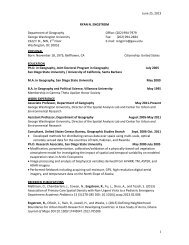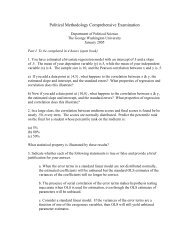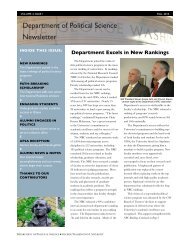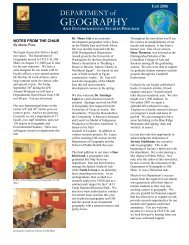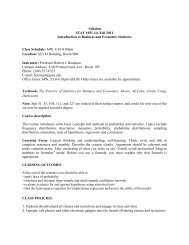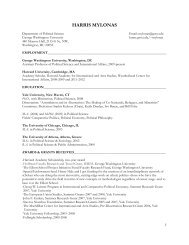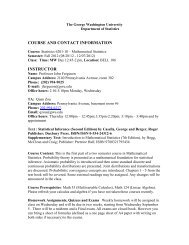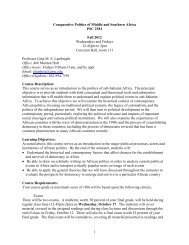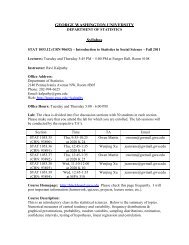Religion - Departments & Programs - George Washington University
Religion - Departments & Programs - George Washington University
Religion - Departments & Programs - George Washington University
Create successful ePaper yourself
Turn your PDF publications into a flip-book with our unique Google optimized e-Paper software.
GW <strong>Religion</strong> Department Newsletter Summer 2012<br />
Reflections on John Bunyan<br />
Dewey Wallace<br />
John Bunyan is no stranger to me. I read The Pilgrim’s Progress as an undergraduate, have taught<br />
it and his autobiography Grace Abounding to the Chief of Sinners in GW classes and elsewhere, have<br />
discussed him in three of my published books, wrote a review essay on the multi-volume Oxford<br />
<strong>University</strong> Press facsimile edition of his Miscellaneous Works in 1993, and spent the first half of my<br />
current sabbatical year researching and writing an invited chapter for a book that Oxford <strong>University</strong> Press<br />
will publish as the Oxford Handbook of John Bunyan. This chapter describes and analyzes the theology of<br />
John Bunyan and required my examination of his many theological treatises (12 of the 13 volumes in the<br />
Miscellaneous Works). And it was a special treat for me to visit the Bedford, England, meeting-house in<br />
which Bunyan preached, and where worshippers still gather surrounded by stained-glass windows<br />
depicting scenes from The Pilgrim’s Progress.<br />
John Bunyan (1628-1688), whose better known narratives in addition to Grace Abounding and The<br />
Pilgrim’s Progress include the wonderfully titled Life and Death of Mr. Badman, was once a household<br />
name in the English speaking world, and, indeed, beyond it (The Pilgrim’s Progress has been translated<br />
into more than one hundred languages). In nineteenth-century America, among the poor and on the<br />
frontier, if a family owned 2 or 3 books, in addition to a Bible and perhaps a dictionary or almanac, would<br />
be The Pilgrim’s Progress. Huck Finn found a copy at one of the places where he stayed and “read<br />
considerable in it,” commenting that it was “about a man that left his family it didn’t say why,” a bit of<br />
Mark Twain’s irony, since the whole book is about that “why”! In Little Women the daughters play<br />
“pilgrim.” Nathaniel Hawthorne in his short story “The Celestial Railroad” provided a reverse parody as<br />
the pilgrims travel by train to a place of increasing smoke and fire. C. S. Lewis, in a more serious vein,<br />
also reversed the story in The Pilgrim’s Regress.<br />
Bunyan was not so widely read at first, although he found readers among England’s dissenting<br />
Baptists and Congregationalists, who would not conform to the ritual and episcopal governance of the<br />
Church of England. Elites on the other hand, sneered at Bunyan. The philosopher David Hume declared<br />
that to like Bunyan’s books indicated bad taste. But Bunyan answered “the captious reader” in advance,<br />
averring that “I intended this Book as little for thee, as the Goldsmith intendeth his Jewels and Rings for<br />
the Snowt [sic] of a Sow.” Bunyan said he wrote for those who have “shallow Purses, short Memories, and<br />
but little time to spare,” not for the well-born.<br />
The tide turned with a growing appreciation of the lively and vivid prose of Bunyan by such<br />
literary arbiters as Samuel Johnson, Robert Southey, and Samuel Taylor Coleridge, himself no mean<br />
theologian as well as poet and critic. Coleridge influentially distinguished the Bunyan of Parnassus (a<br />
mountain peak sacred to Apollo and the muses, patrons of the arts) from the Bunyan of the conventicle<br />
(the drab meetings for Dissenter worship). Thus, one side of Bunyan could be admitted to the literary<br />
salons; the other kept at bay as what Matthew Arnold later called cultural “Philistines.” Coleridge in his<br />
own life had exchanged the conventicle for the “sweetness and light” of Anglican worship.<br />
If Coleridge’s distinction still prevailed, a handbook to Bunyan would perhaps not have needed a<br />
chapter on his theology, and I would not have written this essay. The dismantling of Coleridge’s<br />
distinction has come from several directions. One was a growing appreciation of a wider canon of English<br />
literature that included more vernacular writings expressing the outlook of the downtrodden. The Pilgrim’s<br />
Progress, written while Bunyan was imprisoned for illegal preaching, is prison literature, like some of the<br />
letters of the Apostle Paul--there are a few items of jailhouse memorabilia in the museum attached to the<br />
Bunyan meeting-house in Bedford. No one has pushed this aspect of Bunyan more than the English<br />
Marxist historian Christopher Hill, whose biography of Bunyan in its American edition bears the title A<br />
Tinker and a Poor Man: John Bunyan and His Church (Norton paperback, 1990), a reference to his wife’s<br />
Continued on pg. 9<br />
8



